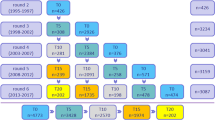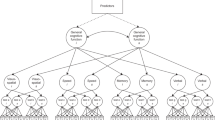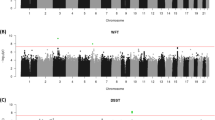Abstract
General intelligence is a heritable trait that is a risk factor for both the onset of dementia and the rate of cognitive decline in community-dwelling older persons. Previous studies screening for quantitative trait loci (QTLs) that influence general intelligence in healthy individuals have identified four loci, two of which are located within the genes insulin-like growth factor 2 receptor (IGF2R) and the Msx1 homeobox. Here, we report the finding of another QTL associated with general intelligence that is located within exon 2 of the cathepsin D (CTSD) gene. A group of 767 healthy adults with a follow-up period of over 15 years have been analyzed for cross-sectional and longitudinal trends in cognitive change using the Heim intelligence test score (AH4-1). We observed a significant association (P=0.01) between a functional C>T (Ala>Val) transition within exon 2 of the CTSD gene that increases the secretion of pro-CTSD from the cell, and the AH4-1 score at initial testing on entry to the longitudinal study. Interestingly, CTSD is transported by IGF2R from the trans Golgi network to the lysosome.
This is a preview of subscription content, access via your institution
Access options
Subscribe to this journal
Receive 12 print issues and online access
$259.00 per year
only $21.58 per issue
Buy this article
- Purchase on Springer Link
- Instant access to full article PDF
Prices may be subject to local taxes which are calculated during checkout
Similar content being viewed by others
References
Bouchard Jr TJ, McGue M . Familial studies of intelligence: a review. Science 1981; 212: 1055–1059.
Schmand B, Smit JH, Geerlings MI, Lindeboom J . The effects of intelligence and education on the development of dementia. A test of the brain reserve hypothesis. Psychol Med 1997; 27: 1337–1344.
Evans DA, Beckett LA, Albert MS, Hebert LE, Scherr PA, Funkenstein HH et al. Level of education and change in cognitive function in a community population of older persons. Ann Epidemiol 1993; 3: 71–77.
MRC CFAS and RIS MRC CFAS. Profile of disability in elderly people: estimates from a longitudinal population study. B M J 1999; 318: 1108–1111.
Pendleton N, Payton A, van den Boogerd EH, Holland F, Diggle P, Rabbitt PM et al. Apolipoprotein E genotype does not predict decline in intelligence in healthy older adults. Neurosci Lett 2002; 324: 74–76.
Chorney MJ, Chorney K, Seese N, Owen MJ, Daniels J, McGuffin P et al. A quantitative trait locus associated with cognitive ability in children. Psychol Sci 1998; 9: 159–166.
Fisher PJ, Turic D, Williams NM, McGuffin P, Asherson P, Ball D et al. DNA pooling identifies QTLs on chromosome 4 for general cognitive ability in children. Hum Mol Genet 1999; 8: 915–922.
Touitou I, Capony F, Brouillet JP, Rochefort H . Missense polymorphism (C/T224) in the human cathepsin D pro-fragment determined by polymerase chain reaction—single strand conformational polymorphism analysis and possible consequences in cancer cells. Eur J Cancer 1994; 30A: 390–394.
Papassotiropoulos A, Bagli M, Feder O, Jessen F, Maier W, Rao ML et al. Genetic polymorphism of cathepsin D is strongly associated with the risk for developing sporadic Alzheimer's disease. Neurosci Lett 1999; 262: 171–174.
Papassotiropoulos A, Bagli M, Kurz A, Kornhuber J, Forstl H, Maier W et al. A genetic variation of cathepsin D is a major risk factor for Alzheimer's disease. Ann Neurol 2000; 47: 399–403.
Crawford FC, Freeman MJ, Schinka J, Abdullah LI, Richards D, Sevush S et al. The genetic association between cathepsin D and Alzheimers disease. Neurosci Lett 2000; 289: 61–65.
McIlroy SP, Dynan KB, McGleenon BM, Lawson JT, Passmore AP . Cathepsin D gene exon 2 polymorphism and sporadic Alzheimer's disease. Neuro Sci Lett 1999; 273: 140–141.
Bhojak TJ, DeKosky ST, Ganguli M, Kamboh M . Genetic polymorphisms in the cathepsin D and interleukin-6 genes and the risk of Alzheimer's disease. Neurosci Lett 2000; 288: 21–24.
Mateo I, Sanchez-Guerra M, Combarros O, Llorca J, Infante J, Gonzalez-Garcia J et al. Lack of association between cathepsin D and Alzheimer disease in a Spanish sample. Am J Med Gen 2002; 114: 31–33.
Bertram L, Blacker D, Crystal A, Mullin K, Keeney D, Jones J et al. Candidate genes showing no evidence for association or linkage with Alzheimer's disease using family-based methodologies. Exp Geron 2000; 35: 1353–1361.
Roberts LR, Adjei PN, Gores GJ . Cathepsins as effector proteases in hepatocytes apoptosis. Cell Biochem Biophys 1999; 30: 71–88.
Ollinger K . Inhibition of cathepsin D prevents free-radical-induced apoptosis in rat cardiomyocytes. Arch Biochem Biophys 2000; 373: 346–351.
Tyynela J, Sohar I, Sleat S, Rosalie MG, Donnelly RJ, Baumann M et al. A mutation in the ovine cathepsin D gene causes a congenital lysosomal storage disease with profound neurodegeneration. EMBOJ 2000; 19: 2786–2792.
Rabbit P, Donlan C, Bent N, McInnes L, Abson V . The University of Manchester Age and Cognitive Performance Research Centre and North East Age Research Longitudinal Programmes, 1982 to 1997. Z Gerontol 1993; 26: 176–183.
Heim AW . The AH 4 Group of Intelligence Tests. NFER-Nelson: Windsor, 1971.
Standard Occupational Classification. Vol. 3, HMSO: London, 1991.
Shibata M, Kanamori S, Ishara K, Ohsawa Y, Konishi A, Kametaka S et al. Participation of cathepsins B and D in apoptosis of PC12 cells following serum deprivation. Biochem Biophys Res Commun 1998; 251: 199–203.
Ishara K, Ohsawa Y, Kanamori S, Shibata M, Waguri S, Sato N et al. Regulation of a novel pathway for cell death by lysosomal aspartic and cysteine proteinases. Neuroscience 1999; 91: 233–249.
Lorenzo K, Ton P, Clark JL, Coulibaly S, Mach L . Invasive properties of murine squamous carcinoma cells: secretion of matrix-degrading cathepsins is attributable to a deficiency in the mannose 6-phosphate/insulin-like growth factor II receptor. Cancer Res 2000; 60: 4070–4076.
Satz P . Brain reserve capacity on symptom onset after brain injury: a formulation and review of evidence for threshold theory. Neuropsychology 1993; 3: 817–824.
Rochefort H, Garcia M, Glondu M, Laurent V, Liaudet E, Rey JM, et al. Cathepsin D in breast cancer: mechanisms and clinical applications, a 1999 overview. Clin Chim Acta 2000; 291: 157–170.
DaCosta SA, Schumaker LM, Ellis MJ . Mannose 6-phosphate/insulin-like growth factor 2 receptor, a bona fide tumor suppressor gene or just a promising candidate? J Mammary Gland Biol Neoplasia 2000; 5: 85–94.
Acknowledgements
This work was supported by the Wellcome Trust. Blood collection and DNA extraction was funded by Research into Ageing.
Author information
Authors and Affiliations
Corresponding author
Rights and permissions
About this article
Cite this article
Payton, A., Holland, F., Diggle, P. et al. Cathepsin D exon 2 polymorphism associated with general intelligence in a healthy older population. Mol Psychiatry 8, 14–18 (2003). https://doi.org/10.1038/sj.mp.4001239
Received:
Revised:
Accepted:
Published:
Issue Date:
DOI: https://doi.org/10.1038/sj.mp.4001239



